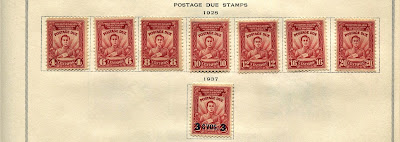1870 Scott 40 4c gray "Ceres"
Lithographed, Imperforate, Bordeaux Issue
Into the Deep Blue
This post will be a continuation discussion about the French Bordeaux issue of 1870-71, and the sometimes confusing similar "Ceres" issues of 1849-50, 1870-73, and the French Colonies imperforates of 1871-77.
For background and introduction, read:
A closer look at the 1870 Bordeaux issue- Intro & 1c, 2c
1870 Scott 40 4c gray "Ceres"
Lithographed, Imperforate, Bordeaux Issue
The lithographic Bordeaux 4c gray has a hefty CV of $200, and is a bit more uncommon than some of the other denominations. It shares the same design as the 1c and 2c denomination Bordeaux stamps.
One doesn't need to worry about confusing the typographic 1849-50 "Ceres" issue, as this frame design was not used.
Close-up: 1870 Scott 40 4c gray "Ceres"
Lithographed, Imperforate, Bordeaux Issue
The Bordeaux 4c gray shares the same characteristic of the other Bordeaux stamps: namely thick curved horizontal lines for the neck markings, and an overall cruder appearance because of the lithographic origins.
Example 1: 1870 Scott 52 4c gray "Ceres"
Typographed, Perf 14 X 13 1/2
The 1870 typographic "Ceres" 4c gray looks similar (CV $40), but the stamps for France are perforated.
Close-up: 1870 Scott 52 4c gray "Ceres"
Typographed, Perf 14 X 13 1/2
A closer look at this typographed specimen shows finer detail, with thinner neck dots and dashes.
Example 2: 1870 Scott 52 4c gray "Ceres"
Typographed, Perf 14 X 13 1/2
This second specimen of the 4c above, looks, color-wise, to be "gray", while the first specimen is more of a "gray-yellow" ( an additional color recognized in the Maury catalogue). Scott only lists one color shade (gray), while Maury lists six shades.
As we mentioned before, the French Colonies general issues of 1871-77 are identical plate wise to the 1870-73 French "Ceres", except they are imperforate. The French Colonies imperforate 1876 Scott 18 4c grey stamp (CV $475) is uncommon (look at the CV!), but one should at least be aware of it. Still, the Bordeaux 1870 4c gray is enough different (lithographic, cruder), that there should not be much confusion.
Example 1: 1870 Scott 41 5c yellow green/ grnsh "Ceres"
Typographed, Imperforate, Bordeaux Issue
The 5c Bordeaux yellow green/ grnsh (CV $160) cannot be possibly mistaken for other issues, as it is the only stamp of this denomination (5c) that has this design and is green.
Close-up: Ex 1: 1870 Scott 41 5c yellow green/ grnsh "Ceres"
Typographed, Imperforate, Bordeaux Issue
Nevertheless, it is good to learn the characteristic of a Bordeaux stamp that is "for sure", a Bordeaux stamp. Note the heavy neck lines.
BTW, I am calling this color "yellow green" (CV $160), although it might qualify as a "green" (CV $175).
Example 2: 1870 Scott 41 5c yellow green/ grnsh "Ceres"
Typographed, Imperforate, Bordeaux Issue
Example 2 is definitely a "yellow-green". Note the characteristic thick neck lines.
1849 Scott 2 15c green / grnsh "Ceres"
Typographed, Imperforate (CV $800)
I am going to show an example of a "green" 1849 "Ceres" stamp, even though it could not possibly be confused with the green 5c Bordeaux stamp, as the denomination is 15c.
Close-up: 1849 Scott 2 15c green / grnsh "Ceres"
Typographed, Imperforate
But, one can take a look at the 1849-50 "Ceres" issue sign: Namely the separate dots on the neck.
French Colonies General Issue
1872 Scott 19 5c green/ pale bl "Ceres"
Typographed, Imperforate
In contrast to the Bordeaux and 1849-50 "Ceres" issue, here is a French Colony General Issue 5c green with a different frame. Obviously, this imperforate 5c French Colony stamp cannot be mistaken for another issue. (But remember that the French 1870-73 issue is perforate, while the 1871-77 French Colony General Issue is imperforate, but otherwise identical in paper, color etc.)
Close-up: French Colonies General Issue
1872 Scott 19 5c green/ pale bl "Ceres"
Typographed, Imperforate
Mistakes can be made between identical stamps of the imperforate 1849-50 "Ceres", and the imperforate 1871-77 French Colony General stamps. (Not in this case however: Different frame and denomination.) Look at the close-up. One does have more dot-dash for the neck lines: similar to the 1849-50 issue. Be aware. !!
What are the imperforate stamp pairings that can confuse?
"Ceres" portrait
French 1850 Scott 1 10c bister/ yelsh (CV $210)
French Colony 1871 Scott 9 10c bister/ yelsh ($130)
French 1849 Scott 4a 20c blue/bluish (CV $2000+)
French Colony 1871 Scott 11 20c blue/bluish ($125)
French 1850 Scott 6a 25c blue/bluish (CV $30)
French Colony 1872 Scott 12 25c blue/bluish (CV $13)
French 1850 Scott 7 40c orange/ yelsh (CV $360)
French Colony 1871 Scott 14 40c orange/yelsh (CV $13)
"Emperor Napoleon" portrait
French 1854 Scott 13 5c green/grnsh (CV$62)
French Colony 1872 Scott 8 5c yellow green/grnsh ($400)
Cancellations can sometimes be helpful. Obviously, if one CV is much less than another CV for a denomination, it is more likely that one has the lessor CV. Also, the French Colony General Issue stamps tend not be as clearly printed.
Out of the Blue
One can see that the various "Ceres" issues can sometimes be confused with one another. But, generally, the Bordeaux issues are enough different that they can be positively identified.
Comments appreciated!


























































